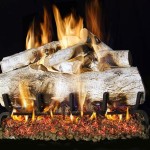Understanding and Managing the Gas Fireplace Burn-Off Smell
A new gas fireplace is a welcome addition to any home, providing warmth and ambiance. However, a common experience for new owners is a distinct burning smell during the initial uses. This odor, often described as a chemical or oily smell, is a normal byproduct of the manufacturing and installation process and is generally referred to as the "burn-off" smell. Understanding the source of this smell, knowing how long it will last, and being aware of strategies to mitigate it are crucial for a positive initial experience with a gas fireplace.
The burn-off smell originates from various sources within the fireplace system. Manufacturing oils and residues, protective coatings applied to metal components to prevent rust during shipping and storage, and even dust accumulated during transit all contribute to the odor. These substances volatilize when the fireplace is first heated, releasing their characteristic smells into the surrounding environment. The intensity of the burn-off smell can vary depending on the specific model of fireplace, the duration and intensity of the initial burns, and the overall ventilation of the room. While generally harmless, the smell can be unpleasant and even cause temporary discomfort in some individuals.
Identifying the Source of the Burn-Off Smell
Pinpointing the source of the burn-off smell can help to understand its cause and anticipate its duration. The smell is not a sign of a gas leak, which typically has a distinct sulfurous or "rotten egg" odor. The burning smell, in contrast, is more akin to hot metal or burning plastic. Key areas contributing to the odor include:
Internal Metal Components: The metal firebox, burner assembly, and venting components are often coated with protective oils or paints during manufacturing. These coatings are designed to prevent corrosion during shipping and storage. When the fireplace is first used, the heat causes these coatings to vaporize, producing a noticeable odor. Different metals and coatings will produce distinct smells, which can vary in intensity and duration.
Manufacturing Residues: During the manufacturing process, residues from cutting, welding, and assembly often remain on the fireplace components. These residues can include lubricants, metal shavings, and cleaning agents. When heated, these residues can release volatile organic compounds (VOCs) into the air, contributing to the burn-off smell. The quality control processes implemented by the manufacturer affect the amount of residual material present and, consequently, the intensity of the smell.
Dust and Debris: Even with careful handling, dust and debris can accumulate inside the fireplace during shipping and installation. This debris can include sawdust, packing materials, and general environmental dust. When the fireplace is ignited, this debris burns and smolders, producing a smoky or dusty odor. Thoroughly cleaning the fireplace before the initial burn can help to minimize this source of the burn-off smell.
Paint and Sealants: Some fireplace models may use paints or sealants on various components. These materials also contain volatile organic compounds (VOCs) that are released upon initial heating. The off-gassing of these materials contributes to the overall burn-off smell. Manufacturers often use specific types of paints and sealants designed to minimize VOC emissions, but some odor is still expected during the initial break-in period.
New logs are also a significant contributor. The fiberglass logs used in gas fireplaces can also have coatings or binders applied during their manufacturing. These materials are designed to improve the log's appearance and durability. However, when exposed to heat, these coatings can release volatile compounds, adding to the burn-off smell. Sometimes the logs require repositioning after the initial burn to ensure even heat distribution, further contributing to the smell as they off-gas in a new arrangement.
Duration and Mitigation Strategies
The duration of the burn-off smell can vary depending on several factors, including the fireplace model, the intensity of the initial burns, and the ventilation of the room. Generally, the smell should dissipate within a few hours of operation, after which it will likely subside completely after several uses. While the burn-off smell is usually temporary, certain strategies can help to expedite the process and minimize its impact.
Initial High-Temperature Burn: The most effective method for mitigating the burn-off smell is to perform an initial high-temperature burn. After installation, operate the fireplace at its highest setting for 2-4 hours. This will help to accelerate the vaporization of the manufacturing oils, residues, and coatings. Adequate ventilation is crucial during this process; open windows and doors to allow the fumes to dissipate quickly. If the smell is particularly strong, consider running an exhaust fan to improve air circulation.
Ventilation and Air Circulation: Adequate ventilation is essential for mitigating the burn-off smell. Opening windows and doors allows fresh air to circulate and dilute the concentration of fumes. Using fans, such as ceiling fans or portable fans, can further enhance air circulation and help to remove the smell from the room more quickly. Ensure that the fireplace damper is fully open to facilitate proper venting of the fumes. If the smell persists despite these measures, consider increasing the ventilation further or reducing the intensity of the burn.
Cleaning the Fireplace: Before the initial burn, carefully inspect the fireplace for any visible dust, debris, or packing materials. Use a soft brush or vacuum cleaner to remove any accumulated debris from the firebox, burner assembly, and logs. Avoid using harsh chemicals or solvents, as these can leave behind residues that contribute to the burn-off smell. A damp cloth may be used to wipe down the interior surfaces, ensuring that all moisture is thoroughly dried before igniting the fireplace.
Air Purifiers: Using an air purifier with a HEPA filter and activated carbon filter can help to remove volatile organic compounds (VOCs) and other airborne particles that contribute to the burn-off smell. HEPA filters are effective at capturing dust and debris, while activated carbon filters absorb odors and gases. Choose an air purifier that is appropriately sized for the room where the fireplace is located and operate it at a high setting during the initial burn-off period.
Addressing Persistent Odors
While the burn-off smell is typically temporary, it is important to address any persistent odors that linger after the initial break-in period. These odors may indicate an underlying issue that requires attention. Persistent smells could be a gas leak, a venting problem, or the presence of foreign objects. If the burn-off smell persists for more than a week or is accompanied by other unusual symptoms, it is essential to investigate further.
Verifying Gas Connections: Any persistent unusual odor should first prompt an inspection for gas leaks. While the typical "burn-off" smell differs from the odorant added to natural gas, any indication of a gas presence warrants immediate attention. Apply a soap-and-water solution to gas connections and look for bubbles, which can indicate a leak. If a gas leak is suspected, immediately shut off the gas supply and contact a qualified gas technician to perform a thorough inspection and repair.
Inspection of Venting System: Ensure that the fireplace venting system is properly installed and functioning correctly. Check for any obstructions or damage to the vent pipes, chimney, or flue. A blocked or improperly installed venting system can prevent proper exhaust of combustion byproducts, leading to a build-up of odors inside the home. If the venting system appears to be damaged or obstructed, contact a qualified chimney sweep or HVAC technician to perform an inspection and make any necessary repairs or adjustments. Venting issues can be dangerous and should be addressed promptly.
Foreign Objects: Investigate the fireplace and surrounding area for any foreign objects that may be contributing to the smell. Check for items such as plastic bags, packing materials, or small toys that may have fallen into the firebox or near the burner assembly. These objects can melt, burn, or smolder when exposed to heat, producing unpleasant or potentially toxic fumes. Remove any foreign objects immediately to prevent further odor issues.
Professional Consultation: If the burn-off smell persists or is accompanied by other unusual symptoms, such as smoke, soot, or carbon monoxide alarms, it is essential to consult with a qualified fireplace technician. A professional technician can perform a thorough inspection of the fireplace and venting system, identify any underlying issues, and recommend appropriate solutions. Do not attempt to diagnose or repair the fireplace yourself, as this can be dangerous and may void the warranty. In persistent cases, the manufacturer may also offer suggestions or alternative solutions based on the fireplace model.

Here S Why Your Gas Fireplace Stinks Full Service Chimney

Here S Why Your Gas Fireplace Stinks Full Service Chimney

Gas Fireplaces The Odors They Can Cause

Why Your Gas Fireplace Stinks Chimney Experts

Why Does My Gas Fireplace Smell Dreifuss Fireplaces

Why Do My Gas Logs Smell Foster Fuels

Why Does My Gas Fireplace Smell Like Kerosene Hunker

Vent Free Fireplace Odor

Gas Fireplaces The Odors They Can Cause

Burn Off Of Your Gas Fireplace Before First Fire








